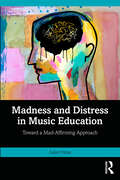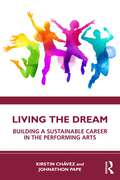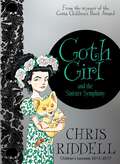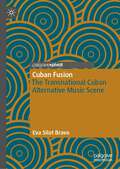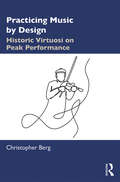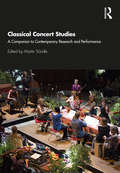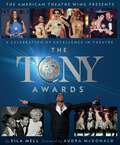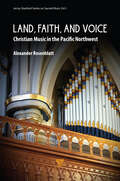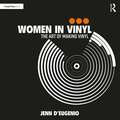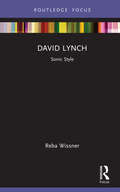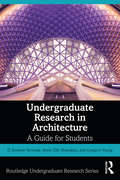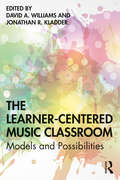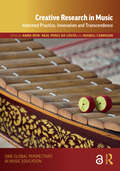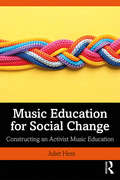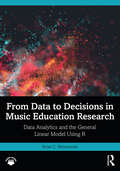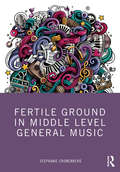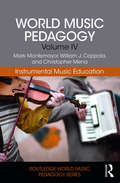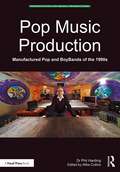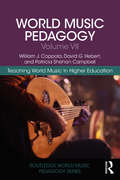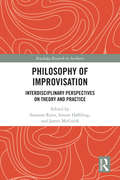- Table View
- List View
Madness and Distress in Music Education: Toward a Mad-Affirming Approach
by Juliet HessMadness and Distress in Music Education offers an in-depth exploration of mental health and emotional distress in the context of music education, offering new ways of thinking about these experiences and constructing ways to support distress through affirming pedagogy, practices, and policies in music education. Centering the lived experiences of 15 people in a range of roles across music education who self-identify an issue with their mental health, the volume addresses impacts on both students and educators. The author draws on Mad Studies and disability studies to present new paradigms for thinking about Madness and distress in the music context. An essential resource for music educators, music education researchers, and preservice students seeking to understand the complexities of mental health in the music classroom, this book considers how people conceptualize their mental health, how distress impacts participation in music education, how music education may support or exacerbate distress, and what supports for distress can be implemented in music education.
Madness and Distress in Music Education: Toward a Mad-Affirming Approach
by Juliet HessMadness and Distress in Music Education offers an in-depth exploration of mental health and emotional distress in the context of music education, offering new ways of thinking about these experiences and constructing ways to support distress through affirming pedagogy, practices, and policies in music education. Centering the lived experiences of 15 people in a range of roles across music education who self-identify an issue with their mental health, the volume addresses impacts on both students and educators. The author draws on Mad Studies and disability studies to present new paradigms for thinking about Madness and distress in the music context. An essential resource for music educators, music education researchers, and preservice students seeking to understand the complexities of mental health in the music classroom, this book considers how people conceptualize their mental health, how distress impacts participation in music education, how music education may support or exacerbate distress, and what supports for distress can be implemented in music education.
Living the Dream: Building a Sustainable Career in the Performing Arts
by Kirstin Chávez Johnathon PapeLiving the Dream: Building a Sustainable Career in the Performing Arts offers an accessible guide to understanding one’s arts career as a business. This essential companion to the inner workings of the arts world begins with defining the dream, including how to conceive mission statements, branding and business plans. Part II covers sharing the dream with others through social media, networking, and working with agents or artist managers. Part III offers an overview of the financial aspect, including budgets, taxes, and managing risks. Part IV concludes by discussing the realities of an arts career, including work/life balance, preparing for the future, and managing mental health. This practical and insightful overview is a must‑have companion for aspiring and early career professionals in the performing arts, as well as students on a range of arts courses, including Music Business, Entrepreneurship, and Career Skills classes.
Living the Dream: Building a Sustainable Career in the Performing Arts
by Kirstin Chávez Johnathon PapeLiving the Dream: Building a Sustainable Career in the Performing Arts offers an accessible guide to understanding one’s arts career as a business. This essential companion to the inner workings of the arts world begins with defining the dream, including how to conceive mission statements, branding and business plans. Part II covers sharing the dream with others through social media, networking, and working with agents or artist managers. Part III offers an overview of the financial aspect, including budgets, taxes, and managing risks. Part IV concludes by discussing the realities of an arts career, including work/life balance, preparing for the future, and managing mental health. This practical and insightful overview is a must‑have companion for aspiring and early career professionals in the performing arts, as well as students on a range of arts courses, including Music Business, Entrepreneurship, and Career Skills classes.
Goth Girl and the Sinister Symphony (Goth Girl #4)
by Chris RiddellThere are musical goings-on and a mystery for Ada to solve in Goth Girl and the Sinister Symphony, the fourth beautifully illustrated adventure in the series from Chris Riddell, 2015–2017 Children's Laureate and author of the Ottoline books.Lord Goth is throwing a music festival at Ghastly-Gorm Hall, with performances from the finest composers in the land. Ada can't wait, but it's quite distracting when her grandmother is trying to find her father a fashionable new wife. And there's a faun living in her wardrobe. Worst of all, Maltravers is up to his old tricks and Ada must make sure everything goes to plan. Luckily, help is at hand – from a very interesting house guest . . .For more in the deliciously dark series, check out the first book and winner of the Costa Children's Book Award, Goth Girl and the Ghost of a Mouse.
Cuban Fusion: The Transnational Cuban Alternative Music Scene
by Eva Silot BravoSurveying the impact of Cuba's economic crisis after the demise of the eastern socialist block, this book documents a relatively unexplored transnational network of collaborations among Cuban musicians that migrated to many different countries from the 1990s forward. The book’s main argument is that in light of the 1990s crisis in Cuba, new transnational and alternative narratives emerged, resulting in creative “in-between” spaces that reflect a post- socialist aesthetic condition. The manuscript also documents important developments in the Cuban jazz and fusion scenes outside the island in the last 20+ years..
Practicing Music by Design: Historic Virtuosi on Peak Performance
by Christopher BergPracticing Music by Design: Historic Virtuosi on Peak Performance explores pedagogical practices for achieving expert skill in performance. It is an account of the relationship between historic practices and modern research, examining the defining characteristics and applications of eight common components of practice from the perspectives of performing artists, master teachers, and scientists. The author presents research past and present designed to help musicians understand the abstract principles behind the concepts. After studying Practicing Music by Design, students and performers will be able to identify areas in their practice that prevent them from developing.The tenets articulated here are universal, not instrument-specific, borne of modern research and the methods of legendary virtuosi and teachers. Those figures discussed include: Luminaries Franz Liszt and Frederic Chopin Renowned performers Anton Rubinstein, Mark Hambourg, Ignace Paderewski, and Sergei Rachmaninoff Extraordinary teachers Theodor Leschetizky, Rafael Joseffy, Leopold Auer, Carl Flesch, and Ivan Galamian Lesser-known musicians who wrote perceptively on the subject, such as violinists Frank Thistleton, Rowsby Woof, Achille Rivarde, and Sydney Robjohns Practicing Music by Design forges old with new connections between research and practice, outlining the practice practices of some of the most virtuosic concert performers in history while ultimately addressing the question: How does all this work to make for better musicians and artists?
Classical Concert Studies: A Companion to Contemporary Research and Performance
by Martin TröndleClassical Concert Studies: A Companion to Contemporary Research and Performance is a landmark publication that maps out a new interdisciplinary field of Concert Studies, offering fresh ways of understanding the classical music concert in the twenty-first century. It brings together essays, research articles, and case studies from scholars and music professionals including musicians, music managers, and concert designers. Gathering both historical and contemporary cases, the contributors draw on approaches from sociology, ethnology, musicology, cultural studies, and other disciplines to create a rich portrait of the classical concert’s past, present, and future.Based on two earlier volumes published in German under the title Das Konzert (The Concert), and with a selection of new chapters written for the English edition, this companion enables students, researchers, and practitioners in the classical and contemporary music fields to understand this emerging field of research, go beyond traditional disciplinary boundaries and methodologies, and spark a renaissance for the classical concert.
The Tony Awards: A Celebration of Excellence in Theatre
by Eila Mell The American Theatre WingCommemorating over 75 years of Broadway greatness with never-before told stories, rare photos from the American Theatre Wings' archives, and interviews with major honorees like Lin-Manuel Miranda, Patti LuPone, and Hugh Jackman, The Tony Awards is the official, authorized guide to Broadway's biggest night.The Tony Awards: A Celebration of Excellence in Theatre pays tribute to the magic that happens when the curtain goes up and Broadway's best and brightest step onto center stage. Supported by the American Theatre Wing, the arts organization that founded the Tony Awards in 1947 and continues to produce the Tony Awards live telecast each year, author Eila Mell has interviewed a cavalcade of past and present Tony winners, including actors, producers, writers, costume designers, and many many others. Their voices fill the pages of this book with fascinating, behind-the-scenes stories about what it's like to win the theatre world's highest honor. Featuring a foreword by Audra McDonald and over 400 color and black-and-white photographs, The Tony Awards also spotlights more than 130 captivating interviews with a parade of industry insiders, including: Mel Brooks, Matthew Broderick, Carol Burnett, Kristin Chenoweth, Glenn Close, James Corden, Bryan Cranston, Neil Patrick Harris, Jennifer Holliday, Hugh Jackman, John Kander, Angela Lansbury, Judith Light, Hal Linden, Kenny Leon, Patti LuPone, Lin-Manuel Miranda, Brian Stokes Mitchell, Rita Moreno, Bernadette Peters, Chita Rivera, Martin Short, Tom Stoppard, Julie Taymor, Leslie Uggams, and Sir Andrew Lloyd Webber.
Land, Faith, and Voice: Christian Music in the Pacific Northwest
by Alexander RosenblattThis book summarizes a decade of research on its topic, while each specific perspective either formed in advance, or arose in the process of ethnography and its analysis. The book explores various aspects of Christian music in British Columbia, Washington State, and Oregon, but primarily its historical facets and local palette. The scope of the main topics covers aspects such as historical and local melodies in relevant hymnbooks, musical practices in the Cathedrals and other churches within the designated area, and the creative profile of modern North American composers (including those who have worked in the Pacific Northwest), who made significant contributions to the church music practiced in the area. Other background and supporting topics are a reference on the history and culture of the Canadian and U.S. parts of the region, the study of Native Christian art, its philosophy and examples, and historical stages and the current landscape of Christianity in British Columbia, Washington State, and Oregon.The book bears the features of a monograph and a handbook at the same time. Among the few other books dealing with specific topics that make up the content of this book, none of them gives an all-around picture of the regional history, society, culture, art, religion, and its musical expression as a holistic phenomenon.
Land, Faith, and Voice: Christian Music in the Pacific Northwest
by Alexander RosenblattThis book summarizes a decade of research on its topic, while each specific perspective either formed in advance, or arose in the process of ethnography and its analysis. The book explores various aspects of Christian music in British Columbia, Washington State, and Oregon, but primarily its historical facets and local palette. The scope of the main topics covers aspects such as historical and local melodies in relevant hymnbooks, musical practices in the Cathedrals and other churches within the designated area, and the creative profile of modern North American composers (including those who have worked in the Pacific Northwest), who made significant contributions to the church music practiced in the area. Other background and supporting topics are a reference on the history and culture of the Canadian and U.S. parts of the region, the study of Native Christian art, its philosophy and examples, and historical stages and the current landscape of Christianity in British Columbia, Washington State, and Oregon.The book bears the features of a monograph and a handbook at the same time. Among the few other books dealing with specific topics that make up the content of this book, none of them gives an all-around picture of the regional history, society, culture, art, religion, and its musical expression as a holistic phenomenon.
Women in Vinyl: The Art of Making Vinyl
by Jenn D’EugenioWomen in Vinyl: The Art of Making Vinyl provides a comprehensive guide to the world of vinyl, with a focus on empowerment, diversity, and inclusion, designed to both demystify the vinyl community and highlight the vital role women and minority groups play in shaping the industry.Divided into each step of the process, the book provides a detailed overview of the vinyl manufacturing process, from lacquer cutting, electroplating, and record pressing, to the roles of record labels, distribution, DJs, and more. With interviews and profiles from global professionals throughout, the book is a first-of-its-kind guide to the vinyl industry and the women who are blazing trails within it. Women in Vinyl is an essential resource for professionals, hobbyists, and students interested in the process of making vinyl, including those who want to deepen their understanding of the vinyl medium and its role in shaping the music industry, as well as for those interested in the work of the organization Women in Vinyl.
Women in Vinyl: The Art of Making Vinyl
by Jenn D’EugenioWomen in Vinyl: The Art of Making Vinyl provides a comprehensive guide to the world of vinyl, with a focus on empowerment, diversity, and inclusion, designed to both demystify the vinyl community and highlight the vital role women and minority groups play in shaping the industry.Divided into each step of the process, the book provides a detailed overview of the vinyl manufacturing process, from lacquer cutting, electroplating, and record pressing, to the roles of record labels, distribution, DJs, and more. With interviews and profiles from global professionals throughout, the book is a first-of-its-kind guide to the vinyl industry and the women who are blazing trails within it. Women in Vinyl is an essential resource for professionals, hobbyists, and students interested in the process of making vinyl, including those who want to deepen their understanding of the vinyl medium and its role in shaping the music industry, as well as for those interested in the work of the organization Women in Vinyl.
David Lynch: Sonic Style (Filmmakers and Their Soundtracks)
by Reba WissnerDirector David Lynch is best known for films that channel the uncanny and the weird into a distinct "Lynchian" aesthetic, in which sound and music play a key role: Lynch not only writes his intended sounds into the script but also often takes on the role of creating the sounds himself. This concise study explores what makes Lynch’s sonic imprint distinct, breaking down three different sound styles that create Lynch’s sound aesthetic across his films. Showing how sound offers new insights into the aesthetic and narrative work of Lynch’s filmmaking, this book highlights new dimensions in the work of a key American auteur and deconstructs the process of building a unique sound world.
David Lynch: Sonic Style (Filmmakers and Their Soundtracks)
by Reba WissnerDirector David Lynch is best known for films that channel the uncanny and the weird into a distinct "Lynchian" aesthetic, in which sound and music play a key role: Lynch not only writes his intended sounds into the script but also often takes on the role of creating the sounds himself. This concise study explores what makes Lynch’s sonic imprint distinct, breaking down three different sound styles that create Lynch’s sound aesthetic across his films. Showing how sound offers new insights into the aesthetic and narrative work of Lynch’s filmmaking, this book highlights new dimensions in the work of a key American auteur and deconstructs the process of building a unique sound world.
Undergraduate Research in Architecture: A Guide for Students (Routledge Undergraduate Research Series)
by D. Andrew Vernooy Jenny Olin Shanahan Gregory YoungUndergraduate Research in Architecture: A Guide for Students supplies tools for scaffolding research skills, with examples of undergraduate research activities and case studies on projects in the various areas of architecture study. Undergraduate research has become a common degree requirement in some disciplines and is growing rapidly. Many undergraduate activities in music have components that could be combined into compelling undergraduate research projects, either in the required curriculum, as part of existing courses, or in capstone courses centered on undergraduate research.Following an overview chapter, the next seven chapters cover research skills including literature reviews, choosing topics, formulating questions, citing sources, disseminating results, and working with data and human subjects. A wide variety of sub-disciplines follow in the remaining chapters, with sample project ideas from each as well as undergraduate research conference abstracts. The final chapter is an annotated guide to online resources. Included are some inspirational quotations concerning architecture’s commitment to research, and some examples of professional research that support the focus of the chapter. All chapters end with relevant questions for discussion.
The Learner-Centered Music Classroom: Models and Possibilities
by David A. Williams Jonathan R. KladderThe Learner-Centered Music Classroom: Models and Possibilities is a resource for practicing music teachers, providing them with practical ideas and lesson plans for implementing learner-centered pedagogical concepts into their music classrooms. The purpose of this book is to propose a variety of learner-centered models for music teaching and learning through the use of a variety of autoethnographic viewpoints. Nine contributors provide working and concrete examples of learner-centered models from their classrooms. Offering lesson plan ideas in each of these areas, the contributors provide practical approaches for implementation of learner-centered approaches in music instruction across a variety of landscapes.Learner-centered teaching provides an approach to music education that encourages social, interactive, culturally responsive, creative, peer-based, open-formed, facilitated and democratic learning. Chapter 1 defines the what, why, and perceived benefits of learner-centered approaches in music teaching and learning contexts Chapters 2-10 will include example lesson plans, rubrics, etc. as models for teachers. The contributors to this book suggest that learner-centered approaches, when embedded into the culture and curricular framework of a music classroom, offer exciting approaches for teaching music in ways that are culturally and educationally appropriate in contemporary education.
Creative Research in Music: Informed Practice, Innovation and Transcendence (ISME Series in Music Education)
by Anna Reid Costa, Neal Peres Da Jeanell CarriganCreative Research in Music explores what it means to be an artistic researcher in music in the twenty-first century. The book delineates the myriad processes that underpin successful artistic research in music, providing best practice exemplars ranging from Western classical art to local indigenous traditions, and from small to large-scale, multi-media and cross-cultural work formats. Drawing on the richness of creative research work at key institutions in South-East Asia and Australian, this book examines the social, political, historical and cultural driving forces that spur and inspire excellence in creative research to extend and to cross boundaries, to sustain our music industry, to advocate for the importance of music in our world, and to make it clear that music matters.In the chapters, our authors present the ideas of informed practice, innovation and transcendence from diverse international perspectives. Each of these three themes has an introductory section where the theme is explored and the chapters in that section introduced. Taken as a whole, the book discusses how the themes in combination, with reference to the authorial group, are able to transform music pedagogy and performance for our global and complex world.Chapter 9 of this book is freely available as a downloadable Open Access PDF at http://www.taylorfrancis.com under a Creative Commons Attribution-Non Commercial-No Derivatives (CC-BY-NC-ND) 4.0 license.
Music Education for Social Change: Constructing an Activist Music Education
by Juliet HessMusic Education for Social Change: Constructing an Activist Music Education develops an activist music education rooted in principles of social justice and anti-oppression. Based on the interviews of 20 activist-musicians across the United States and Canada, the book explores the common themes, perceptions, and philosophies among them, positioning these activist-musicians as catalysts for change in music education while raising the question: amidst racism and violence targeted at people who embody difference, how can music education contribute to changing the social climate? Music has long played a role in activism and resistance. By drawing upon this rich tradition, educators can position activist music education as part of a long-term response to events, as a crucial initiative to respond to ongoing oppression, and as an opportunity for youth to develop collective, expressive, and critical thinking skills. This emergent activist music education—like activism pushing toward social change—focuses on bringing people together, expressing experiences, and identifying (and challenging) oppressions. Grounded in practice with examples integrated throughout the text, Music Education for Social Change is an imperative and urgent consideration of what may be possible through music and music education.
From Data to Decisions in Music Education Research: Data Analytics and the General Linear Model Using R
by Brian C. WesolowskiFrom Data to Decisions in Music Education Research provides a structured and hands-on approach to working with empirical data in the context of music education research. Using step-by-step tutorials with in-depth examples of music education data, this book draws upon concepts in data science and statistics to provide a comprehensive framework for working with a variety of data and solving data-driven problems.All of the skills presented here use the R programming language, a free, open-source statistical computing and graphics environment. Using R enables readers to refine their computational thinking abilities and data literacy skills while facilitating reproducibility, replication, and transparency of data analysis in the field. The book offers: A clear and comprehensive framework for thinking about data analysis processes in a music education context. An overview of common data structures and data types used in statistical programming and data analytics. Techniques for cleaning, preprocessing, manipulating, aggregating, and mining data in ways that facilitate organization and interpretation. Methods for summarizing and visualizing data to help identify structures, patterns, and trends within data sets. Detailed applications of descriptive, diagnostic, and predictive analytics processes. Step-by-step code for all concepts and analyses. Direct access to all data sets and R script files through the accompanying eResource. From Data to Decisions in Music Education Research offers a reference "cookbook" of code and programming recipes written with the graduate music education student in mind and breaks down data analysis processes and skills in an approachable fashion. It can be used across a wide range of graduate music education courses that rely on the application of empirical data analyses and will be useful to all music education scholars and professionals seeking to enhance their use of quantitative data.
Fertile Ground in Middle Level General Music
by Stephanie CronenbergFertile Ground in Middle Level General Music guides music educators to inspire their middle level students (grades 5–8) to engage more deeply in the general music classroom, where students are given the opportunity to "try on" a range of roles: musician, composer, listener, and critic. The book outlines the Fertile Ground Framework, a teacher's aide for curricular decision-making that unites the middle level concept with the National Core Arts Standards while emphasizing the developmental needs and cultural identities of students. This resource-rich book provides teachers with an array of adaptable classroom support tools, including: Lesson sequences Activity ideas Teacher resources and worksheets "Do-Now" exercises Featuring the real-world perspectives of thirteen music educators, Fertile Ground in Middle Level General Music is both practical and theoretical, presenting methods for creating rich, inspiring learning environments in middle level general music classrooms of all shapes and sizes, and highlighting the unacknowledged strengths that already exist therein. Focused on the aim of motivating students to pursue lifelong music learning, this book helps instructors find joy and excitement in teaching a wide array of musical topics to diverse groups of middle level music students.
World Music Pedagogy, Volume IV: Teaching World Music In Higher Education (Routledge World Music Pedagogy Series)
by Mark Montemayor William Coppola Christopher MenaWorld Music Pedagogy, Volume IV: Instrumental Music Education provides the perspectives and resources to help music educators craft world-inclusive instrumental music programs in their teaching practices. Given that school instrumental music programs—concert bands, symphony orchestras, and related ensembles—have borne musical traditions that broadly reflect Western art music and military bands, instructors are often educated within the European conservatory framework. Yet a culturally diverse and inclusive music pedagogy can enrich, expand, and transform these instrumental music programs to great effect.Drawing from years of experience as practicing music educators and band and orchestra leaders, the authors present a vision characterized by both real-world applicability and a great depth of perspective. Lesson plans, rehearsal strategies, and vignettes from practicing teachers constitute valuable resources. With carefully tuned ears to intellectual currents throughout the broader music education community, World Music Pedagogy, Volume IV provides readers with practical approaches and strategies for creating world-inclusive instrumental music programs.
Pop Music Production: Manufactured Pop and BoyBands of the 1990s (ISSN)
by Phil HardingPop Music Production delves into academic depths around the culture, the business, the songwriting, and most importantly, the pop music production process. Phil Harding balances autobiographical discussion of events and relationships with academic analysis to offer poignant points on the value of pure popular music, particularly in relation to BoyBands and how creative pop production and songwriting teams function.Included here are practical resources, such as recording studio equipment lists, producer business deal examples and a 12-step mixing technique, where Harding expands upon previously released material to explain how ‘Stay Another Day’ by East 17 changed his approach to mixing forever. However, it is important to note that Harding almost downplays his involvement in his career. At no point is he center stage; he humbly discusses his position within the greater scheme of events. Pop Music Production offers cutting-edge analysis of a genre rarely afforded academic attention.This book is aimed at lecturers and students in the subject fields of Music Production, Audio Engineering, Music Technology, Popular Songwriting Studies and Popular Music Culture. It is suitable for all levels of study from FE students through to PhD researchers. Pop Music Production is also designed as a follow-up to Harding’s first book PWL from the Factory Floor (2010, Cherry Red Books), a memoir of his time working with 1980s pop production and songwriting powerhouse, Stock Aitken Waterman, at PWL Studios.
World Music Pedagogy, Volume VII: Teaching World Music in Higher Education (Routledge World Music Pedagogy Series)
by William J. Coppola David G. Hebert Patricia Shehan CampbellWorld Music Pedagogy, Volume VII: Teaching World Music in Higher Education addresses a pedagogical pathway of varied strategies for teaching world music in higher education, offering concrete means for diversifying undergraduate studies through world music culture courses. While the first six volumes in this series have detailed theoretical and applied principles of World Music Pedagogy within K-12 public schools and broader communities, this seventh volume is chiefly concerned with infusing culture-rich musical experiences through world music courses at the tertiary level, presenting a compelling argument for the growing need for such perspectives and approaches.These chapters include discussions of the logical trajectories of the framework into world music courses, through which the authors seek to challenge the status quo of lecture-only academic courses in some college and university music programs. Unique to this series, each of these chapters illustrates practical procedures for incorporating the WMP framework into sample classes. However, this volume (like the rest of the series) is not a prescriptive "recipe book" of lesson plans. Rather, it seeks to enrich the conversation surrounding cultural diversity in music through philosophically-rooted, social justice-conscious, and practice-oriented perspectives.
Philosophy of Improvisation: Interdisciplinary Perspectives on Theory and Practice (Routledge Research in Aesthetics)
by Susanne Ravn; Simon Høffding; James McGuirkThis volume brings together philosophical and interdisciplinary perspectives on improvisation. The contributions connect the theoretical dimensions of improvisation with different viewpoints on its practice in the arts and the classroom. The chapters address the phenomenon of improvisation in two related ways. On the one hand, they attend to the lived practices of improvisation both within and without the arts in order to explain the phenomenon. They also extend the scope of improvisational practices to include the role of improvisation in habit and in planned action, at both individual and collective levels. Drawing on recent work done in the philosophy of mind, they address questions such as whether improvisation is a single unified phenomenon or whether it entails different senses that can be discerned theoretically and practically. Finally, they ask after the special kind of improvisational expertise which characterizes musicians, dancers, and other practitioners, an expertise marked by the artist’s ability to participate competently in complex situations while deliberately relinquishing control. Philosophy of Improvisation will appeal to anyone with a strong interest in improvisation, to researchers working in philosophy, aesthetics, and pedagogy as well as practitioners involved in different kinds of music, dance, and theater performances.
